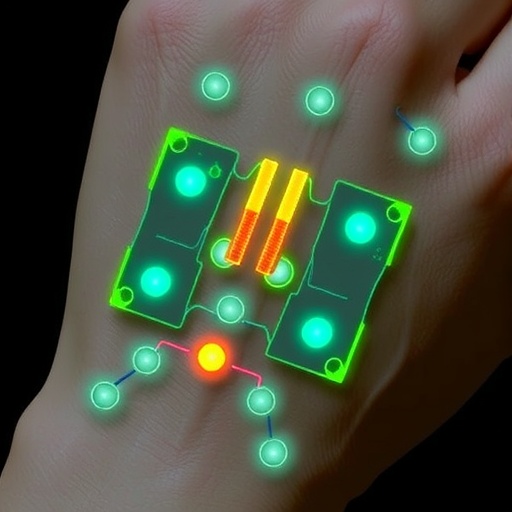In the rapidly evolving field of wearable technology, the importance of developing biosensors capable of reliably monitoring physiological parameters cannot be overstated. Innovative designs that incorporate features such as mechanical flexibility, stretchability, and enhanced operational stability are essential for creating devices that conform to the complexities of the human skin. In this context, a pioneering advancement has been made with the introduction of skin-like drift-free biosensors based on stretchable diode-connected organic field-effect transistors (OFETs). This breakthrough promises significant implications for continuous health monitoring systems, particularly in scenarios requiring real-time data acquisition in challenging environments.
Traditional organic field-effect transistors have shown promising capabilities for biosensing applications; however, they often suffer from signal distortions due to environmental factors such as bending, stretching, moisture, and temperature fluctuations. These issues can lead to unexpected signal artefacts and drifts, complicating the tasks of data interpretation and reliability in biosensing applications. Researchers have addressed these challenges head-on to develop a new breed of biosensors that maintain signal integrity even under varied physical stresses and environmental conditions.
The novel biosensors utilize capacitive coupling combined with interference signal subtraction techniques. This method employs two extended gates that are functionally differentiated through the use of specific target and reference bioreceptors. Such a setup is invaluable, as it not only enhances the sensitivity of the sensors but also drastically reduces signal distortion—by an impressive two orders of magnitude compared to standard organic field-effect transistors that lack this configuration. This stark improvement in performance is particularly notable when faced with various stressors such as bias stress instability, uniaxial strain (up to 100%), and compression (up to 50 mN), as well as temperature changes ranging from 25 to 40 degrees Celsius.
Applications of these advanced biosensors are vast, with initial testing focusing on aptamer-based sensing for cortisol, enzyme-based sensing for glucose, and potentiometric sensing for sodium ions utilizing ion-selective membranes. Each of these applications presents unique challenges, including the need for specificity, sensitivity, and rapid response times. The ability of these biosensors to deliver reliable data under varying conditions enhances their suitability for personal health applications, particularly in monitoring stress-related biomarkers and metabolic parameters.
Moreover, this research culminates in the integration of a hybrid wearable system that consolidates soft sensors and a flexible printed circuit board. This innovative design allows for seamless wireless communication with smartphone applications, bridging the gap between complex biosensing technology and user accessibility. As these devices communicate with smartphones, users can easily access real-time health metrics, supporting informed decision-making regarding personal wellness and health management.
In practical terms, one of the applications of this cutting-edge technology has been demonstrated through cortisol sensing from human sweat during acute stress events. Stress hormones like cortisol play a critical role in numerous physiological processes, and the ability to monitor their levels non-invasively offers tremendous potential benefits for both clinical and everyday health assessments. This capability not only paves the way for timely detection of stress responses but also fosters greater mindfulness and well-being practices among users.
The implications of this research extend beyond simple monitoring; they touch upon the broader objectives of preventative healthcare. Accessing physiological data continuously allows for the early identification of health issues, potentially leading to preemptive measures before conditions escalate. This aligns perfectly with the growing emphasis placed on health management and the continuous monitoring of physiological states as a pathway to improved outcomes.
As healthcare technology continues to progress, integrating biosensor technology seamlessly into our daily lives will increasingly become a reality. The incorporation of skin-like, stretchable biosensors that remain functionally robust under mechanical stress represents a critical step in this ongoing revolution, setting the stage for future innovations that could redefine personal and remote healthcare.
In conclusion, the development of skin-like drift-free biosensors reliant on stretchable diode-connected organic field-effect transistors marks a significant milestone in wearable technology. These devices have been meticulously designed to withstand environmental challenges while providing accurate and reliable biosensing capabilities. As the world continues to embrace digital health and personalized medicine, such advancements will crucially shape the landscape of future health monitoring solutions. The potential to transform how individuals interact with their health data and respond to physiological cues underscores the transformative power of modern biosensor technology.
As this research gains momentum, it is anticipated that these biosensors will inspire further innovations within the field, laying the groundwork for advanced, multifunctional wearable devices that seamlessly integrate into everyday life. Ultimately, as technology merges with biology, the future of health monitoring will be characterized by enhanced precision, proactive healthcare management, and improved quality of life for individuals across the globe.
Subject of Research: Development of skin-like drift-free biosensors utilizing stretchable diode-connected organic field-effect transistors.
Article Title: Skin-like drift-free biosensors with stretchable diode-connected organic field-effect transistors.
Article References:
Zhao, C., Park, J., Maulà, D. et al. Skin-like drift-free biosensors with stretchable diode-connected organic field-effect transistors.
Nat Electron (2025). https://doi.org/10.1038/s41928-025-01465-4
Image Credits: AI Generated
DOI:
Keywords: Wearable technology, biosensors, organic field-effect transistors, health monitoring, cortisol sensing, glucose sensing, sodium ion sensing, personal health applications, real-time monitoring, digital health.




